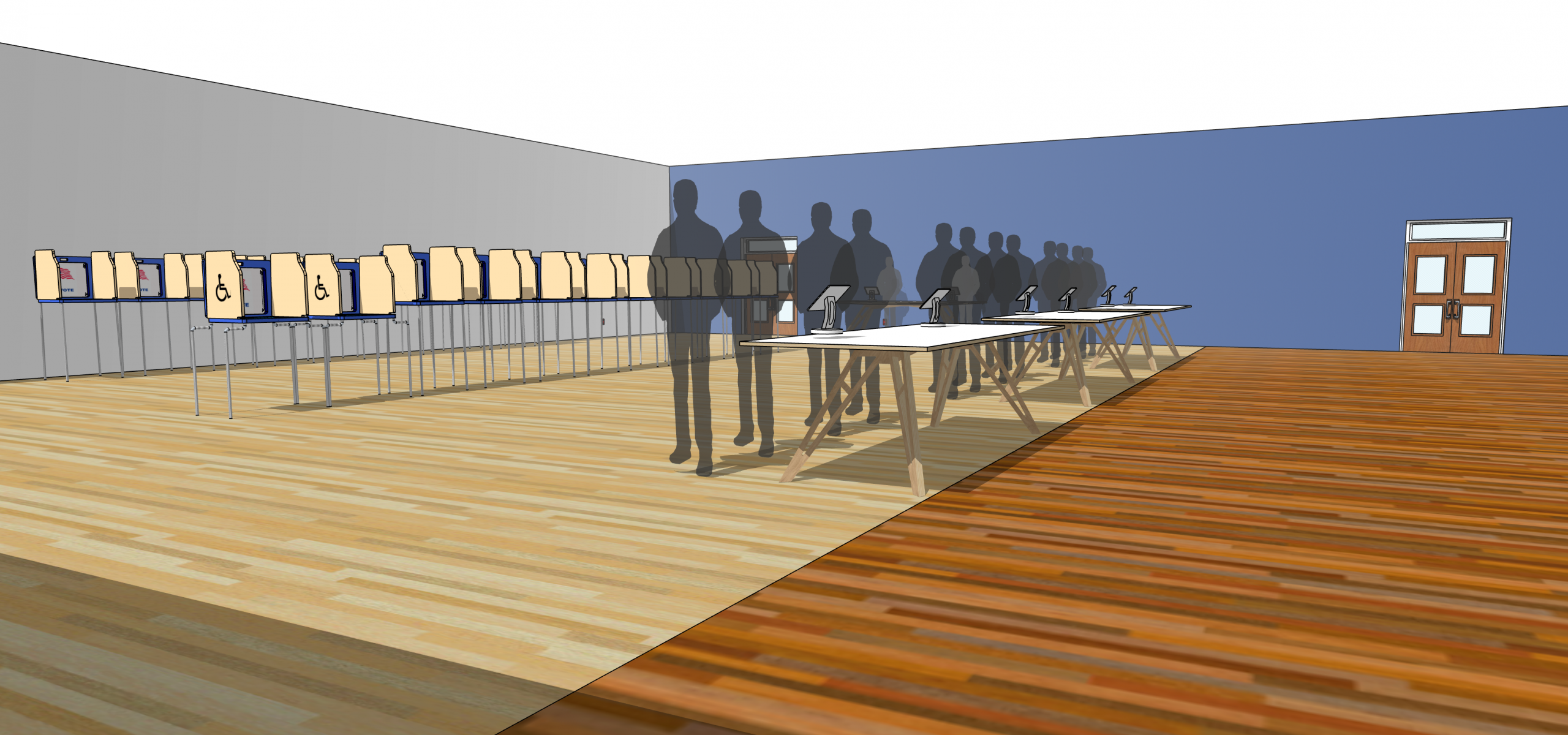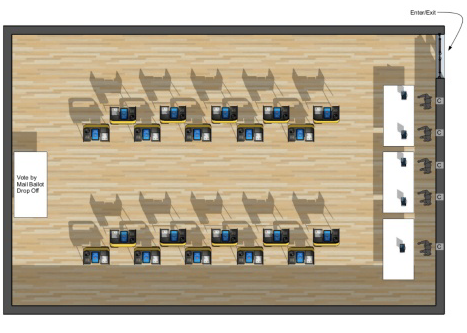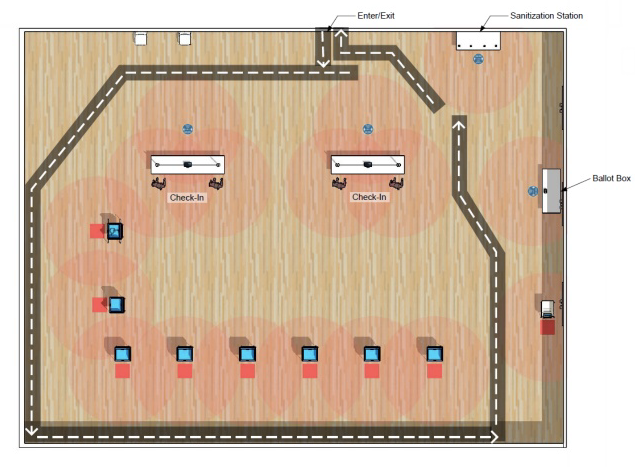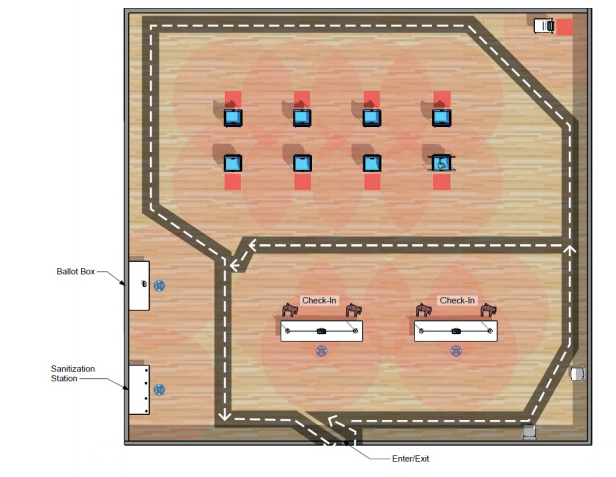Planning Participation in the COVID-19 Pandemic: Polling Location Resource Allocation and Layout

Across the globe, in-person voting at predetermined locations is how voters are accustomed to casting a ballot. However, the 2020 COVID-19 Pandemic presents unique challenges for this well-established participatory norm. Administrative planning for in-person voting that is modified for social distancing to reduce the potential for disease transmission and responsive to variations in the types of buildings used for in-person voting has rapidly become a concern for state and local election administrations in the United States and Election Management Bodies (EMBs) around the world. In addition to identifying and implementing modifications to polling locations, election administrators also face the challenge of understanding how COVID-19 responsive polling location modifications can affect what voters experience when casting a ballot.
Addressing these challenges requires an interdisciplinary approach that incorporates the recommendations of domestic and international health organizations, national and state guidelines, as well as the skills and expertise of relevant disciplines. Utilizing this approach, the University of Rhode Island Voter OperaTions & Election Systems (URI VOTES) lab has leveraged the expertise offered by political science, systems and industrial engineering, and architectural engineering along with guidance from relevant professional associations to understand the implications of COVID-19 modifications in polling locations and the potential consequences of changes on the voter experience.
Polling Location Resource Allocation & Layout
There are a variety of building types that are used for in-person voting. According to the 2016 Survey on the Performance of American Elections, the majority (56%) of voters in the United States report casting a ballot in public buildings, which are defined as schools (24%), government offices (19%), police or fire departments (6.2%), and libraries (5.8%). Civic buildings accounted for nearly all of the remaining polling places, with 17% of respondents voting in churches, 16% in community centers, and 3.6% in senior centers. 3.3% voted in private businesses, stores, or shopping centers (Survey on the Performance of American Elections 2018).2 In addition to variations in type, the sizes of the rooms in many of the buildings that are used for in-person voting range from very small (less than 1,000 square feet or 92.9 square meters) to very large (more than 6,000 square feet or 557.4 square meters). These rooms, particularly those that are small present unique challenges for in-person voting in light of the COVID-19 Pandemic. In a given polling location, resources are necessary for voter check-in and ballot casting. This includes poll workers, paper poll books or electronic poll books (ePollbooks), voting booths, voting machines or ballot boxes, and a variety of other resources. Although the quantity of each resource provided for a given location may be determined by statute, the allocation of resources is often determined by relying on previous experiences with a polling location. During the pandemic, rule of thumb or experiential determinations of resource allocation are not sufficient to adequately account for social distancing and potential changes in voter behavior. To ensure that voters and poll workers have adequate space to navigate the polling location, changes to the allocation of resources are often necessary. Figure 1 and Figure 2 illustrate this point.
 Figure 1
Figure 1
Figure 1 displays a potential layout of voting resources in a polling location with five check-in stations and 20 voting machines (Ballot Marking Devices). Figure 2 displays resource allocation reductions in the polling location to accommodate for a 6 foot (1.83 meters) social distance ring around each voter and poll worker and a 3 foot (.91 meters) unidirectional path that voters use to navigate the polling location.3 With these considerations, the number of check-in stations is reduced to two and the number of voting machines is reduced to five.
Although the previous example relied on a reduction in equipment to accommodate social distancing, the dimensionality of a polling location may allow for a layout that does not require a reduction in equipment. In instances where there are statues that govern the allocation of resources or specific resource needs to meet the demands for in-person voting, changes in the layout can allow for the same allocation of resources across spaces of different sizes.
 Figure 2
Figure 2
As an example, both of the polling locations in Figure 3 and Figure 4 include two check-in stations, eight voting booths, one Americans with Disabilities (ADA) compliant accessible voting machine, one ballot box or optical scanner, chairs for two observers, and one sanitation station. Although the polling location in Figure 3 is 4,340 square feet (1,322.8 square meters) and the polling location in Figure 4 is 2,929 square feet (829.8 square meters), the layout of each location accommodates the same amount of equipment while maintaining space for a 6-foot social distancing ring for voters and poll workers and 3-foot unidirectional path.
Location Selection
 Figure 3. Layout in Polling Location (4,340 square feet)
Figure 3. Layout in Polling Location (4,340 square feet)
In addition to modifying the layout of traditional polling locations, non-traditional polling locations might also serve a polling location in areas where there is a high volume of voters. Sports stadiums and arenas are examples of two existing building types that not only provide the space necessary for social distancing but also address other architectural and engineering strategies that can reduce the risk of exposure to COVID-19.4
In-Person Voting Experience
 Figure 4. Layout in Polling Location (2,929 square feet)
Figure 4. Layout in Polling Location (2,929 square feet)
To understand what voters will experience when voting in-person, simulation models that replicate resource allocation and layout plans, administrative processes for check-in, ballot completion, ballot casting, and voter arrival patterns can be used to understand how many voters an individual polling location can process throughout in-person voting days. Simulation models can also be used to better understand how the resource allocation in polling locations in conjunction with predicted voter turnout can affect the minimum, maximum, or average time that a voter will wait in line or spend in the in-person voting system. In instances where the simulations produce results for polling locations that exceed the jurisdiction standard for time in queue or time in system, adjustments to the number of voters assigned to a polling location or the number and size of polling locations can be made where permissible.5 During the COVID-19 Pandemic, the simulations can be especially valuable when changes are made to polling locations that have been used in previous elections or new buildings and rooms that allow for enhanced COVID-19 precautions are identified for in-person voting.
Involvement of Local Election Officials
As states and nations assess, identify, and implement changes to in-person voting that are responsive to the COVID-19 Pandemic, the expertise of the local election officials is invaluable. Although responsibilities vary across nations, local election officials are often responsible for voter registration, maintaining up to date records of eligible registered voters, voter education, voting machine maintenance, recruiting and training poll workers, ballot preparation and approval, vote tabulation, and so much more. Communication with and the involvement of these individuals across phases of the decision-making process is invaluable as local officials also have an in-depth understanding of the voters and communities they serve and an awareness of challenges populations may experience as a result of changes (eg. moving polling locations).
Conclusion
COVID-19 has created unique planning challenges for election administrators. However, by using existing resources and tools for polling location resource allocation and layout, decisions about modifications for in-person voting can be made with confidence about what voters are likely to experience on Election Day(s).
1 Bridgett A. King, Ph.D. is an associate professor in the Department of Political Science at Auburn University, Auburn, Alabama, USA. The current focus of King’s research includes the consequences of felony disenfranchisement for democratic governance, citizen confidence in electoral outcomes and processes, and applying industrial and systems engineering and architectural engineering approaches to the field of election administration to address challenges associated with administrative decision making and voter experiences. King serves as the director of the Master of Public Administration Program at Auburn University, a Research Partner with the University of Rhode Island Voter OperaTions & Election Systems (URI VOTES) lab, a Affiliated Researcher with the Public Affairs Research Council of Alabama (PARCA), and an instructor in the Election Center Certified Elections/Registration Administrator (CERA) Program.
2 Stewart, Charles, 2017, "2016 Survey of the Performance of American Elections", https://doi.org/10.7910/DVN/Y38VIQ, Harvard Dataverse, V1.
3 A minimum of 6 feet for social distancing is recommended by the Centers for Disease Control in the United States (https://www.cdc.gov/coronavirus/2019-ncov/php/risk-assessment.html). The size of the social distance ring can be modified based on the standards of individual countries.
4 For a forthcoming comprehensive list of strategies visit: https://web.uri.edu/urivotes/
